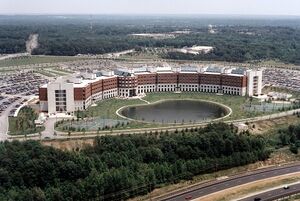Anagonian Military Joint Command Center
Confederate Military Joint Command Center
History
The Confederate Military Joint Command Center (CMJCC), commonly known as the JCC, was established around 55 AUR (1965 CE) under the administration of President Forest Holloway. Holloway, a former Chief Admiral of the Confederate Navy with a distinguished military career in both the Confederate Navy and the United Republic Navy prior to its collapse, recognized the need for a centralized command and control facility.
The CMJCC was initially conceived as a joint command center for the multiple branches of the armed forces. At the time of its construction and completion, Colonel Hughes Jackson had just become the first Anagonian in space, and the Confederate Space Agency (CASA) was in the early stages of launching primitive satellites. Battlefield technology was transitioning into the early computer age, though it remained quite rudimentary compared to modern standards. It was during this crucial time in technological development that President Holloway ordered the construction of the JCC.
Over the years, the role of the CMJCC evolved. It continues to be equipped with state-of-the-art technology to ensure its operational capability in the event of an apocalyptic scenario. The facility is the primary bunker for government and military officials, providing a secure refuge during national crises. It also is the permanent central hub for unified combat operations across all branches, facilitating proper communication, command & control, and collaboration between all the branches of the Confederate States Armed Forces.
In peacetime, the JCC is adaptable for various uses, including functioning as a makeshift hospital in the event of mass casualty events. Its robust underground infrastructure includes multiple levels for storing equipment, weapons, and other essential supplies. This setup allows the CMJCC to provide extensive civilian assistance and maintain security during emergencies.
Features
- Command and Control: The CMJCC serves as the central hub for coordinating military operations across the various branches of the armed forces.
- Emergency Shelter: Designed to withstand apocalyptic events, it offers a secure refuge for high-level government and military personnel.
- Medical Facilities: The large medical wing can be utilized for treating casualties and providing emergency medical care during peacetime and crises.
- Underground Infrastructure: The facility includes several levels dedicated to storing crucial supplies, equipment, and weapons to support ongoing operations and emergencies.
The CMJCC remains a vital component of the Confederate States' defense and emergency response strategy, reflecting the foresight and leadership of President Forest Holloway and his commitment to national security.
Specifications
| Feature | Details |
|---|---|
| Height (At tallest point) | 73ft |
| Width (At widest point) | 63ft |
| Length | 723ft |
| Total square feet | 45,549 feet |
| Feature | Details |
|---|---|
| Defense level | 3-1mt nuclear weapon |
| Power source | x1 AET5000 Tokamak Thermonuclear Fusion Reactor, located under the underground facility |
| x1 Erathore Military Industries Magneto Hydrodynamic Generator, located within the underground facility | |
| Secondary power source | x2 Smaller EMI Magneto Hydrodynamic Generators located 0.7mi away underground, protected by 3ft of concrete and durasteel |
| Tertiary power source | x10 Standard AM500 Diesel Power Generators located 2.2mi away above-ground, protected by concrete fencing and electric fence |
| Food supplies | 3500 people for 6 months |
| Hospital | 3500 capacity |
| Feature | Details |
|---|---|
| Total square feet | 23,456 feet |
| Depth underground | 350ft |
| Power source | x1 EMI Magneto Hydrodynamic Generator, separate from the MHG for the main building |
| Hospital | 2500 capacity |
| Type | Details |
|---|---|
| Ground Vehicles | 120 contained in an underground basement |
| Planes | 50 contained in an underground runway |
| Attribute | Details |
|---|---|
| Length | 4500 ft (last 500 ft are open to the sky) |
| Notes | Underground and protected by a few feet of concrete and other materials, the runway would be of normal length, opening up within the last 500 ft or so to allow planes to take off. 9 ft thick blast doors protect from outside endangerment. |
| Attribute | Details |
|---|---|
| Number | 20 |
| Location | Contained 150 ft underground in preparation area |
| Notes | An elevator-style system would be used. The helicopters would be able to run their tests and warm up while being lifted to the surface, where they can immediately take off. |

